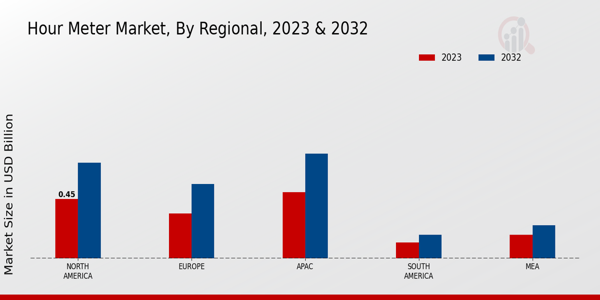Growing Focus on Preventive Maintenance
The emphasis on preventive maintenance is a key driver in the Global Hour Meter Market Industry. Organizations are increasingly recognizing the value of regular maintenance to extend equipment lifespan and minimize unexpected failures. Hour meters facilitate this approach by providing accurate data on usage, enabling timely maintenance interventions. As industries strive to enhance operational efficiency, the market is projected to grow significantly, reaching 3.05 USD Billion by 2035. This shift towards preventive maintenance not only reduces costs but also enhances productivity, making hour meters indispensable tools in various sectors.
Increasing Demand for Equipment Monitoring
The Global Hour Meter Market Industry experiences a surge in demand for equipment monitoring solutions across various sectors. Industries such as construction, agriculture, and manufacturing increasingly rely on hour meters to track operational hours and maintenance schedules. This trend is driven by the need for enhanced efficiency and reduced downtime. As a result, the market is projected to reach 1.76 USD Billion in 2024, reflecting a growing recognition of the importance of precise monitoring in optimizing equipment performance. Companies are investing in advanced hour meter technologies to ensure compliance with maintenance protocols, thereby fostering growth in the Global Hour Meter Market Industry.
Regulatory Compliance and Safety Standards
Regulatory compliance and safety standards significantly influence the Global Hour Meter Market Industry. Governments worldwide are implementing stringent regulations to ensure equipment safety and operational efficiency. Hour meters serve as essential tools for tracking usage and maintenance, helping companies adhere to these regulations. For instance, industries such as transportation and construction are mandated to maintain accurate records of equipment usage to comply with safety standards. This regulatory landscape is likely to propel the market forward, as organizations prioritize compliance and safety, thereby driving demand for hour meters in various sectors.
Technological Advancements in Hour Meter Solutions
Technological innovations play a pivotal role in shaping the Global Hour Meter Market Industry. The integration of digital technologies, such as IoT and cloud computing, enhances the functionality of hour meters, allowing for real-time data collection and analysis. These advancements enable users to monitor equipment remotely, facilitating proactive maintenance and reducing operational costs. As industries increasingly adopt smart technologies, the market is expected to witness a compound annual growth rate of 5.13% from 2025 to 2035. This growth trajectory underscores the potential of advanced hour meter solutions in driving efficiency and productivity across various sectors.
Expansion of the Construction and Agriculture Sectors
The expansion of the construction and agriculture sectors contributes to the growth of the Global Hour Meter Market Industry. As these industries continue to evolve, the demand for reliable equipment monitoring solutions increases. Hour meters are crucial in tracking the operational hours of machinery used in construction and agricultural activities, ensuring optimal performance and maintenance. The robust growth in these sectors is expected to drive the market forward, as companies seek to enhance efficiency and reduce downtime. This trend indicates a promising future for hour meter technologies, aligning with the overall expansion of the Global Hour Meter Market Industry.























Leave a Comment